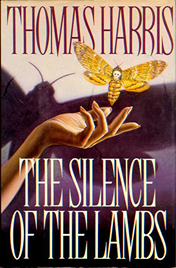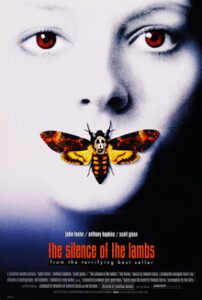When I was a kid, still too young to watch horror movies, there were a few film names that would
When I was a kid, still too young to watch horror movies, there were a few film names that would make me feel a little scared but mostly curious. “The Silence of the Lambs” is an excellent example. There was something about the name that made me imagine something terrible, perhaps a mass slaughter of innocent animals. When I was old enough to watch movies of this kind—sometime in middle school, if I remember correctly—it was one of the first on my list to watch. While I don’t recall the film leaving me with any particular trauma on the first viewing (or the ones that followed), it is undoubtedly one of the best and most influential horror thrillers we have ever seen.
Some 33 years have passed since then, and “The Silence of the Lambs” still holds some remarkable achievements (for example, being the only horror film to win an Oscar for Best Picture). As you should know, this is a horror classic with a chilling performance by Anthony Hopkins as the cannibalistic serial killer Hannibal Lecter and a powerful performance by Jodie Foster as FBI agent Clarice, masterful direction by Jonathan Demme, and some unforgettable scenes.
Interestingly, the story behind the film and its production process is undoubtedly unique, as you can learn from the following overview of facts about “The Silence of the Lambs,” some of which are better known and some less. Here are some facts about “The Silence of the Lambs”, including the production, influences, and importance.
What Is The Silence Of The Lambs About?
Most horror fans probably know the name of the villain in the film “The Silence of the Lambs” (Hannibal Lecter, of course). Hannibal Lecter originated in Thomas Harris’s books, the first of which was “Red Dragon” from 1981. The book first introduced the character of psychiatrist and serial killer Dr. Hannibal Lecter, who used to eat his victims. At its opening, the film depicted an FBI pursuit of a terrible killer known as the “Tooth Fairy,” who used to break into houses, kill household members, and have sex with the woman’s corpse. The book’s hero is Will Graham, who had previously captured Lecter and realizes that he must use him to catch “The Tooth Fairy,” a technician obsessed with the paintings of the “Big Red Dragon.”

The book “The Silence of the Lambs” was published in 1888, and this time introduced Agent Clarice Sterling in her attempt to catch an equally terrible serial killer: the killer who was nicknamed “Buffalo Bill,” in part because of his fondness for imprisoning young women in his house, skinning them and throwing their bodies in a pit. In the book “Hannibal” (1999), Dr. Lecter escapes from prison and faces off against the agent Clarice, who tries to capture him.
The books didn’t get rave reviews but became bestsellers, especially after the movie that changed everything.
How Many Hannibal Lecter Movies Are There?
The order in which the books were adapted into films is different. The first film to introduce the character of Dr. Hannibal Lecter to the world was Michael Mann’s 1986 film “Manhunter,” in which Brian Cox – then at the beginning of his career – stepped into Lecter’s shoes in a movie based on Mann’s Red Dragon.
“The Silence of the Lambs,” directed by Jonathan Demme, was released in 1991. In 2001, the sequel “Hannibal” arrived, followed by two more prequel films. The first was “Red Dragon” (2002) with Edward Norton, also starring Lecter, which was average.
The next prequel on the list was Peter Weber’s 2006 film “Hannibal Rising,” which features Lecter as a child. The young Hannibal Lecter was played by French actor Gaspard Ulliel, with a recognizable scar on his left cheek (evidence for his attack by a Rottweiler), who unfortunately died in 2022, at the age of 37, in a skiing accident in France.
There was also a three-season TV series called “Hannibal” (2013-2015), which examines the relationship between Dr. Hannibal Lecter (this time played by Mads Mikkelsen) and FBI agent Will Graham (Hugh Dancy).
Here is the trailer of “The Silence of the Lambs” to get things started:
The Silence Of The Lambs Is The Only Horror Film To Win An Oscar
We have already written on the website about the Academy of Motion Picture Arts and Sciences’ disregard for horror films. They did not ignore “The Silence of the Lambs” either, and rightly so. “The Silence of the Lambs” is only the third film, and the last so far, to win all five of the most important awards: Best Picture, Best Director (Jonathan Demme), Best Actor (Anthony Hopkins), Best Actress (Jodie Foster) and Best Screenplay (Ted Tally). The previous two to do so were Frank Capra’s screwball comedy “It Happened One Night” from 1934 and Milos Forman’s “One Flew Over the Cuckoo’s Nest” from 1975.
One of the main fun facts about”The Silence of the Lambs” is that this is only horror film to win Best Picture at the Oscars up to date, and unfortunately, it is hard to see when this fact will change.
Anthony Hopkins Wins Oscar Despite Limited Screen Time
Despite his relatively short running time, Anthony Hopkins’ blood-curdling performance as Dr. Hannibal Lecter earned him one of the most deserved Academy Awards. Hopkins’s screen time is exactly 24:52 minutes, with only David Niven winning an Oscar with fewer minutes (for 1958’s “Separate Tables,” in which he appeared for just 23:39 minutes). If you consider the film’s length, Hopkins ranks first because he is on screen for only about 21% of the film.
Undoubtedly, other portrayals of Dr. Hannibal Lecter are much less successful than what Sir Anthony Hopkins did here. He has become so identified with the villain that another satisfactory, chilling performance by a given actor can almost immediately trigger comparisons to that iconic performance. Not long ago, “Longlegs” got some fantastic reviews by critics and the audience alike. Many described it as “the modern Silence of the Lambs” and honored the excellent performance by Cage as a particularly psychotic serial killer. Although Cage has also been compared to Hopkins, and his role is superb, we are not discussing the same performance level here.
The Silence Of The Lambs Created Unforgettable Villain And Heroine
This performance was also enough for Hopkins to receive first place on the list of the greatest film villains by the American Film Institute, marking the institute’s 100th anniversary. Hopkins was ahead of, among others, Norman Bates from “Psycho,” Darth Vader from the “Star Wars” franchise, the Wicked Witch of the West from “The Wizard of Oz,” Nurse Ratched from “One Flew Over the Cuckoo’s Nest,” and many others unforgettable movie villains.
Jodie Foster is ranked sixth on the list of movie heroes, after Atticus Finch (“To Kill a Mockingbird”), Indiana Jones (“Raiders of the Lost Ark”), James Bond (“Dr. No”), Rick Blaine (“Casablanca”) and Will Kane (“High Noon”). Foster is the highest-ranked woman on this list, just ahead of Ellen Ripley from the “Alien” films in eighth place.
Anthony Hopkins Researched Serial Killers (And Reptiles)
Initially, when Hopkins received a call from his agent telling him he was sending him a script for a film called “The Silence of the Lambs,” he thought it was a children’s film. After reading the script, he understood the film’s complexity, which was aimed at a much older audience.
To prepare for the role, Anthony Hopkins researched in-depth the cases of famous serial killers. He studied topics such as psychopathy and anthropology, visited prisons, interviewed convicted murderers, and watched court hearings on the subject. All of this helped him create a character who is, while evil, also educated – which further increases the fear of her. Jonathan Demme described him as a “good man too, (who) just trapped in an insane mind.” and Hopkins himself compared the character to the artificial intelligence robot HAL 9000 in Kubrick’s “2001: A Space Odyssey”: “a complex, brilliant, rational killing machine that seems to know everything that’s going on around it.”
Hopkins also based his character on people he knew, such as a London friend who rarely blinked while he spoke, which made those around him uncomfortable. Hopkins’ minimal blinking in the film is also influenced by the fact that he noticed at the time that reptiles blink minimally: they blink consciously, only when the situation requires it. Hopkins tried to do something similar in the film.
The Film Kept Hopkins’ Career Alive
Over the years, Anthony Hopkins has said that the film was one of his last attempts to become a real star in Hollywood. Although he had been making films since the 1960s, he did not get the status he wanted to reach. In interviews, he described that if this film had not been successful, he would have stopped appearing in movies and focused on acting on the theater stage.
The rest, of course, is history. “The Silence of the Lambs” was a huge success; everyone raved about Hopkins’ acting, and he became one of the most prominent actors in Hollywood in the following decades. He was nominated for an Oscar six times and won twice. In his most recent win for the touching “The Father” (2021,) he masterfully portrayed the character of an elderly man suffering from memory loss and dementia. Hopkins is currently the oldest actor to win an Oscar, at the age of 84.
Anthony Hopkins Improvised Several Iconic Scenes
Hopkins is said to have improvised several significant scenes in the film, such as his imitation of Clarice Sterling’s Southern accent during their first meeting. Jodie Foster later said she was so surprised by the imitation that her reaction to the imitation was authentic. In that scene, Hopkins realizes that he should look directly at the camera as Clarice’s character enters his field of vision to create an image of Lecter as a “Mr. Know All.”
Hopkins’ rough, rapid “chewing” sound that Hopkins makes when describing one of his meals is also an improvisation. Director Jonathan Demme initially opposed him because he thought he was annoying, but everyone around him seemed to like the idea, and the director decided to go with the flow. Hopkins described the character’s voice, one of the memorable elements in his performance, as “a combination of Truman Capote and Katharine Hepburn.”
Hopkins Brought His Fear Of Dentists To The Character
Hopkins also took part in the character’s design. The initial plan was that in the scene where Dr. Lecter moves from Baltimore, he would wear a yellow or orange jumpsuit, which, as we all know, is associated with prisoners. Hopkins thought the character would be scarier if dressed in white and managed to convince Demme and costume designer Colleen Atwood. He later said that he got the inspiration for this outfit from his fear of dentists.
Jonathan Demme Wanted Michelle Pfeiffer As Clarice
Today, we feel as if Jodie Foster was born to play Clarice, but if you ask Jonathan Demme – everything could have been different. Ted Tally, who wrote the script for the film, did suggest Foster early. But when Demme got the director role, he imagined no other than Michelle Pfeiffer. The idea fell through because Pfeiffer wanted more than the two million dollars she was offered for the role.
Jonathan Demme decided to meet with Jodie Foster, who wanted the role. After one meeting, He decided to cast her, partly because he liked the determined way she walked towards him. He felt she had the strength and determination to play a woman’s role in a man’s world, facing the most horrific sights imaginable.
The FBI Was A Senior Partner In The Film
Quite unusually, the American Federal Bureau of Investigation (FBI) – or instead, the FBI’s Crime Scene Unit – was a partner in the film. They contributed to the creators in building the character and describing the investigation process, partly because, at that time, the FBI wanted to increase the number of female agents in their agency. They hoped that the film’s success would lead to more women reaching key positions in the agency, which did happen to some extent.
An FBI agent assisted Jodie Foster before filming to build together the language and behavior of a young FBI agent. One of the most memorable scenes in her excellent performance, when she stands by the car and cries, is actually that agent’s idea.
Today, we believe “The Silence of the Lambs” has changed the portrait of FBI agents in popular culture. While previously, their representation was mainly stereotypical and one-dimensional, the film helped to portray them as much more complex and profound characters.
Gene Hackman (and Jodie Foster) Wanted To Produce The Film
Legendary actor Gene Hackman, now 95, could have been Dr. Hannibal Lecter at some point. He bought the rights to the novel himself, beating Jodie Foster, who also wanted the rights.
Hackman considered directing the film and playing one of the main characters (Dr. Lecter or Jack Crawford). His performance in 1988’s “Mississippi Burning” changed his mind. When he watched a clip from the film at the Oscars a year later, he felt uncomfortable playing a violent character at this point, and he waived his rights.
Perhaps one reason for the refusal is that, quite unusually, Hackman was known for his modesty and the fact that he did not hesitate to accept supporting roles in many films, which other senior actors might have refused because they saw them as “disrespectful” or “a step-down.”
The Silence Of The Lambs Poster Is A Work Of Art
“The Silence of the Lambs” poster is considered famous and fascinating. In fact, in 2006, the original poster was announced as the best in the last 35 years at the Key Art Awards.

In the poster art, we see a pale girl with a yellow moth covering her mouth on the poster. The pale-looking woman has red eyes, which may signify innocence or danger because red is associated with blood and fear. Beyond the moth being a nocturnal creature that lives a life filled with complete darkness – which corresponds with one of the most famous and frightening scenes in the film – its representation corresponds to the themes that the film raises on several levels.
According to some analyses, the representation of the moth in the poster contributes to the character’s fragility, expresses the motif of silence (it covers the mouth, after all), or suggests that people are not interested in listening to what that woman has to say.
The moth motif will recur several times in the film, partly because Buffalo Bill places a mothball in the throat of his victims. If you focus on the face of the moth in the poster, you see that it is not a skull but a group of naked people, which also hints at what will happen in the film. This visual image is actually “In Voluptas Mors” (meaning “In the Pleasure of Death”), a photograph created by the surrealist artist Salvador Dali in 1951, who, together with photographer Philippe Halsman, combined seven naked women into a shape reminiscent of a human skull.
The poster’s use of yellow and black symbolizes danger, like traffic signs that attract the human eye. According to some analyses, it indicates the moths’ similarity to a bee, which we should be aware of to avoid stung.
Here is a video with “The Shining of the Lambs” poster analysis:
Buffalo Bill Dance Scene Didn’t Appear On The Script
Although many people remember “The Silence of the Lambs” mainly for the character of Dr. Hannibal Lecter, we should not forget that the main antagonist in the film is the serial killer Jame Gumb, also known as “Buffalo Bill”, played creepily by Ted Levine. We cant make an article with some facts about “The Silence of the Lambs” and ignore the villain and one of the most memorable scenes from the movie.
Buffalo Bill is an entirely psychotic character who was greatly influenced by the serial killer Ed Gein, “the Butcher of Plainfield,” who stole bodies from cemeteries and committed obscene and sadistic acts in them. Gein also murdered at least several women because they allegedly reminded him of his mother (who did not love him back). His madness, such as the fact that he would cut off organs and make objects from them, explains why he was an inspiration for several iconic horror characters, such as Norman Bates in “Psycho,” “Leatherface” in the “Texas Chainsaw Massacre” films, and more.
The character of Buffalo Bill is a killer in a man’s body who wants to become a woman and undergo a transformation like this that a moth goes through in its life cycle. One of the most memorable scenes in the film is the dance of the naked Buffalo Bill, which is also one of the most famous dancing scenes in horror movies ever. Buffalo Bill dances to the sound of “Goodbye Horses” by American singer Q Lazzarus. At the same time, he shapeshifts into a female character, especially when an unhappy girl is in his house’s cellar. This Buffalo Bill dance scene appeared in Thomas Harris’ book but not in the original script. However, Ted Levine insisted that it would be a part of the film because, in his opinion, it contributed significantly to shaping the character.






